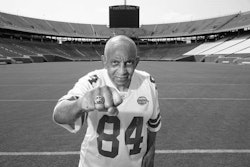Please don’t call Andy Walker the next Tiger Woods. He’s too busy being the first Andy Walker.
One of the few African Americans playing National Collegiate
Athletic Association (NCAA) Division I-A golf, Walker is believed to be
the first Black to play on a NCAA Division I men’s golf championship
team after Pepperdine University clinched that title in Chicago in May.
A few years ago, LaRee Suggs was a part of the UCLA women’s national
championship team. Walker, a rising senior, says he is used to “being
the only Black kid out there playing.”
No one apparently is keeping score of the number of African
Americans playing college golf, but all say it is a very small
percentage of the total. John David, executive director of the Minority
Golf Association of America (MGAA), estimated it at one-tenth of one
percent.
But that is about to change, many people think, due largely to the
stunning impact that Tiger Woods – whose father is Black and mother is
Asian – made on the world of golf. Woods, whose record-breaking
performance at The Masters in April electrified the nation, was not
only the first person of color to win the Grand Slam event, he was also
the youngest. As such, he has become a lightning rod attracting young
people particularly African Americans – to the game.
“We’ve been punching holes in the wall for the last few years,” David said. “Tiger knocked the wall down in one afternoon.”
While he avoids comparison, Walker, one of two Blacks to play in the
Division I championship, acknowledges the superstar’s contribution.
“He’s the best player in the world,” he said. “I know he opened up
doors for me. People go out and expect to see me on a golf course. They
see me hit the ball and know it is not a fluke. When I turn pro, he
will have opened up doors for me in other ways. He handles himself so
well. He’s an educated man who is not going to go out and say, ‘Whuz
up?’ or anything like that. That’s important.”
Sources of Inspiration
Walker, like Woods, took up golf at an early age. His father
introduced him to the game because his father felt that golf, which
takes hours to play, would keep his son away from trouble. At the age
of six or seven, the Phoenix native didn’t really think about being the
only Black kid on the course. But as time went on, he says, “I knew it.
I always tried to use it as an inspiration because I knew that someday
other kids would be looking at me.”
Neither of his parents attended a four-year college. His father, now
a retired state government employee, graduated from a two-year business
college. His mother supervises the laundry at a county hospital.
Walker, who will enter his senior year at Pepperdine in the fall,
plans to graduate before he turns professional. He is majoring in
business administration and maintains about a 2.7 grade-point average.
“I was the first Black on my high school team,” says Walker. “I was
the only Black in most of the major junior tournaments I played. I was
the first Black on the team at Pepperdine, so I’m sort of used to it.
Golf is still not totally integrated, but it’s made huge strides in the
past couple of years.”
But those strides often got shortened by the ignorant. Walker
recalls that just a couple of months ago, when he played in a
tournament in Texas, he got the kind of reality check that has happened
before. After a round of 70 – a good day in any golfer’s book – he
returned to the club house and, despite being dressed in golf clothes,
was approached by a white golfer who said, “Hey, go grab my clubs.” He
had been mistaken for a caddie.
Walker’s reply? “I had to tell him I don’t work here, I play golf here.”
Such slights have happened before and Walker expects they will happen again.
“You try to laugh it off,” he says. “People are going to be
ignorant. They don’t like you if you play well. They don’t like you if
you are Black. People are going to find something not to like you for.
I use it as inspiration.”
Walker, who played other sports in high school, decided that his future was brighter in golf.
“Golf is different every day,” he says, explaining his attraction to
the game. “Anybody can play well one day. But if you play well often,
you have to be in tune with yourself. Its adjusting every day and
finding ways every day of getting the ball in the hole.”
“The Tip of the Iceberg”
Although that challenge is what Walker and others hope will appeal
to minorities, the appeal of a college education – which can be paid
for with golf scholarships could also prove to be strong.
Jim Geiberger, Walker’s coach at Pepperdine, said he is already
seeing an increase in the number of Black golfers. He credits the
increase, in part, to improved minority access to country clubs which
have better facilities to develop skills. There are also developmental
programs for duffers in the inner city, “for kids who don’t know what
golf is.”
“This is just the tip of the iceberg in terms of a push in
popularity,” says Geiberger, who also gives credit to Woods for making
golf popular with segments of society that haven’t historically been
drawn to the game.
According to Geiberger, that popularity will lead to an improvement in the pool of talented Black golfers seeking scholarships.
“Andy Walker may be the first Black [man] to be a member of the
national championship team, but he won’t be the last,” predicts
Geiberger.
Jim Hames, executive director of the Golf Coaches Association of
America, comprised of men’s golf coaches at NCAA institutions,
concurred, saying, “It boils down to talent. It may take some time for
African Americans to catch up, but somewhere down the line, more Black
kids will be playing it in college.”
Hames says one negative assumption that is being challenged is the
notion that golf is a sport only accessible to whites at country clubs,
which have a history of restricting access. However, those restrictions
are being eliminated – albeit slowly in some cases. Nevertheless, there
are also more and better public courses available.
“Certainly it boils down to one population that has embraced the
game because of opportunity,” Hames says. “But in the case of Black
kids, it is also a game their peers don’t play. You play the games your
buddies play, and that has been basketball or baseball or football.
“Golf is a difficult game to play and play well. It is a game that
takes a lot of time. You can’t go play it in an hour. Those factors
lend themselves not to stay with the game – and that is not just Black
kids.
“Basically, we have to allow junior programs to do an outstanding
job and get kids into the games, get coaches to-work to develop them
and bring them to a level where they will be noticed. College coaches
look for the best players. If you can shoot par, it doesn’t matter if
you are green. You will play and you will be embraced by everybody.”
Creating Opportunities for Kids
That is what David is doing with the MGAA, which he says works with
fifty or sixty various organizations to attract minorities to the game.
“We’ve got over 10,000 [members] since 1991 with a retention rate of
86 percent,” David says. “Some of them will compete for college
scholarships and I preach it to them every time I see a kid. Not only
about golf scholarships, but also about golf management schools, design
schools, golf engineering, broadcast communications, sales, licensing.
“This is a multi-billion dollar business,” he continues. “People can
have huge careers. Even if they don’t do that, corporate America
analyzes potential employees on the golf course. Corporate executives
are taking to the golf course even more because when people are in
business today, they do their networking on the golf course.
“And even gifted golfers who don’t make it to the [Professional
Golfers Association] tour can teach golf, or be a pro or assistant golf
pro at a country club. You are not just limited to playing on the
tour,” concludes David.
Collegiate Duffers
Level of NCAA Competition Div. I Div. II Div. III
number of men's golf teams 279 180 224
number of women's golf teams 163 46 72
Under National Collegiate Athletic Association (NCAA) rules,
Division I and II teams may each offer five full scholarships. They
are permitted to divide up the scholarships any way they see it. For
example, a team may choose to offer ten half scholarships instead of
five full ones. Division III teams do not offer scholarships.
The NCAA does not keep records on how much money is actually
involved, because each college charges different tuition. The NCAA
also does not keep statistics on the ethnicity of college golfers.
According to David, Woods has agreed to work with the MGAA to help
the association “reach out and get these kids that historically have
not looked at golf.” The association has aligned itself with the
International Junior Golf Tour and the Inner City Junior Golf Tour to
organize seventy events around the country this year.
“These kids do not have an opportunity to play in tournament events, so we create them,” he explains.
The MGAA has established strong ties with NCAA institutions, David
says, “so they can be supplied with a list of names of the kids. If we
have a kid shooting 72 and he’s fifteen years old, colleges’ eyes will
open up and they will place the calls.”
The association’s work with the International Junior Golf Tour
involves inviting minority youth to watch youngsters from thirteen
different countries play golf. The touring youngsters put on
exhibitions and hold clinics, according to David.
“It is kids teaching kids. Then, kids who win our events are invited to play in International Junior golf Tour events.”
Pool Will Remain Shallow for a Time
Although interest and enthusiasm for the game are surging in the
minority community, many caution not to expect an overnight change in
the complexion of college golf. Eddie Payton, golf coach at Jackson
State University and the dean of Black college golf, says that it will
be ten or twelve years before colleges will reap what is being sown
today.
“Most of the young people that Tiger affects are a generation we
won’t see for another ten years or so,” Payton says. “They’ll
matriculate in college in ten or twelve years. It could be a
significant impact at that time.”
Youngsters in high school now, though they may have been bitten by
the golf bug, will simply “not have the skills to help a good
competitive golf program,” he says. “They may be motivated, but there
is so much water under the bridge that they are going to be a little
late.”
Until then, the pool of Black collegiate golfers will remain
shallow, Payton said, explaining that even Black colleges that offer
golf must rely on white players to complete their rosters. Some
historically Black colleges, like many in the Southwestern Athletic
Conference (SAC) to which Jackson State belongs, have golf teams that
are predominantly white, a situation that doesn’t sit well with some
alumni and friends of the institutions.
But Payton says he asks them, “Why are there Black basketball
players at Kentucky? It is about being competitive. It doesn’t make a
difference what color you are as long as you can play and the colleges
want to be competitive. The Black pool is awfully shallow right now,
but ten years from now it is going to be deeper and richer.”
But everybody must continue to push for better accessibility to top
facilities, says Payton, and for proper guidance and exposure.
“That’s what Tiger has had. He is one of the greatest natural
athletes in this game and has had all the advantages that most inner
city and poor kids will never have. He is a polished product and a lot
of kids with disadvantaged backgrounds do not have that advantage, even
if they have the talent. Without those advantages, they can’t play
under conditions that will help them improve their games,” explains
Payton.
He urges major golf associations, as well as professional golfers,
both in terms of expertise and money, to help “develop these kids.
Until they get the expertise and money to get it done, there will be a
void between what they do and what we’d like them to do.”
Plans for the Future
As for Andy Walker, he returns to Pepperdine in the fall.
“I am going to enjoy the national championship with my team, then go
back and defend the title and prove it was no fluke,” said Walker.
“We’re going into it this year knowing what we have to do. After that,
I’m going to turn professional.”
The professional tour has long been a dream and Walker said that if
Tiger Woods doesn’t become the first Black Grand Slam winner, he plans
to be. To complete the Grand Slam, a golfer needs to win The Masters,
The U.S. Open, The British Open and the PGA tournament.
This summer, as he did last summer, Walker will teach golf to youngsters for free.
“Without that help, most of them won’t be introduced to golf or have
any instruction,” he says. “I know they can’t pay $120 for a half-hour
lesson. I always said if I had an opportunity, I would help other kids.”
When he returns to Pepperdine, he will be joined on the golf team by another Black player.
“When I walk up to the tee this year, I am sure they’ll say,
‘There’s Andy Walker, one of the Black guys on Pepperdine’s team,'”
says Walker. “When there are two of us, that’s probably just as many as
some of the teams in the SAC.”
COPYRIGHT 1997 Cox, Matthews & Associates
© Copyright 2005 by DiverseEducation.com


















